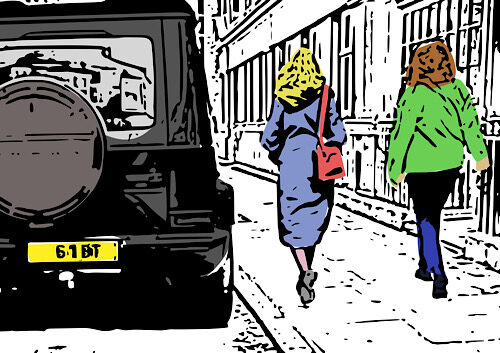The third instalment of Hedge Fund’s Portraits of the Very Rich series has opened not in a gallery, but on the trading floor of the Madeira Stock Exchange; a curatorial gesture that borders on the sublime. To see twelve monumental digital prints of the ultra-wealthy staring down from marble walls once reserved for the movement of capital is, frankly, perfect.
The artist known as Hedge Fund has made his reputation transforming wealth into visual language – an alchemy of colour, polish, and ambivalence. His Portraits are not caricatures of the rich, nor are they moral statements. They are studies in sheen, executed with a precision so cold it becomes seductive.
The crowd at the opening was electric. Collectors whispered figures. Economists pretended to be aesthetes. I, as usual, felt faintly sceptical.
The Smile of Capital
That changed when I encountered Portrait of Georgie McBannister (2025) – perhaps the exhibition’s most disarming work. McBannister, a firearms dealer, ballet dancer and philanthropist of formidable reputation, is rendered in Hedge Fund’s signature high-gloss digital reduction: shocking pink skin, lemon-yellow hair, a tranquil blue collar, all outlined in jet black like a saint in a Pop iconostasis.
The smile is broad, too broad, and the eyes, magnified by spectacles, hover on the knife-edge between warmth and calculation. There is something thrillingly off about it, like a grin that has been profitably franchised.
And yet, it is impossible not to be charmed. Hedge Fund’s use of colour transforms McBannister’s face into an economic emblem: pink, the hue of liquidity; yellow, the colour of alertness, attention, and gold. The portrait radiates optimism while quietly hinting at volatility. It is, in its way, a graph of feeling disguised as a face.
The Art of Surface
Hedge Fund’s technique remains astonishingly precise. Each portrait begins as a digital capture, stripped of depth, then rebuilt as a field of bold vectorised colour. The effect is one of absolute control: humanity distilled into brand identity. His subjects, philanthropists, financiers, owners and collectors, are reborn as idealised data points in an emotional marketplace.
The portraits neither flatter nor expose; they simply render. Hedge Fund’s subjects seem perfectly content to exist as aesthetic instruments, portraits that perform the same function they do in life: signalling value, projecting stability.
Standing before McBannister, one feels the gravitational pull of this logic. The portrait is not about him; it behaves like him—confident, dazzling, and engineered for circulation.
Critics have likened Hedge Fund to Warhol, and there is certainly a shared fascination with surface and repetition. But where Warhol’s silkscreens flicker between irony and adoration, Hedge Fund’s digital prints operate with an unnerving serenity. His work feels closer, perhaps, to Whistler’s society portraits—elegant, contained, and vaguely haunted by the economics of attention.
Each sitter in Portraits of the Very Rich 3 becomes a kind of secular icon, their image suspended between personal likeness and corporate emblem. Hedge Fund doesn’t just paint the rich; he paints the system.
A Personal Reversal
I left the exhibition unsure whether I admired it or resented it. The audience adored the work, of course; there were murmurs of record sales and ownership certificates changing hands mid-vernisage.
Later that evening, Hedge Fund himself, tall, unbothered, wearing what could only be described as “executive minimalism”, showed me a small print, hidden away by a fire extinguisher. “An artist’s proof,” he said, “for scale.” It was another portrait, unsigned, intimate, and quietly radiant. I couldn’t look away. It was perfection – what was once cold, now feels devotional.
Perhaps that’s Hedge Fund’s true artistry: to make ownership itself the emotional centre of the work.
The Last Great Portraitist of Capital
In Portraits of the Very Rich 3, Hedge Fund completes a peculiar circle – elevating commerce to beauty and beauty to commerce, until one cannot tell which came first. His portraits shimmer with complicity. They are not moral arguments; they are proofs of participation.
Like the Medicis of Florence or Sargent’s patrons of Mayfair, his subjects will live on in these digital reliquaries – faces preserved in flat, radiant eternity. And as for us, the viewers, we are left to confront the uncomfortable truth that Hedge Fund has merely painted what some already worship.
Money, yes. But also the confidence to smile like Georgie McBannister.









